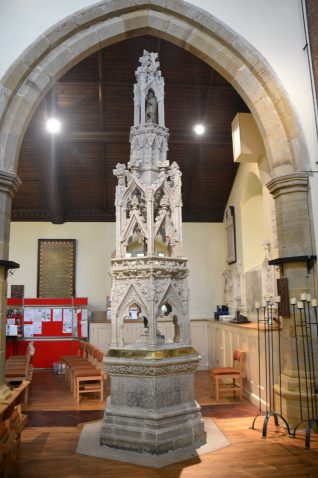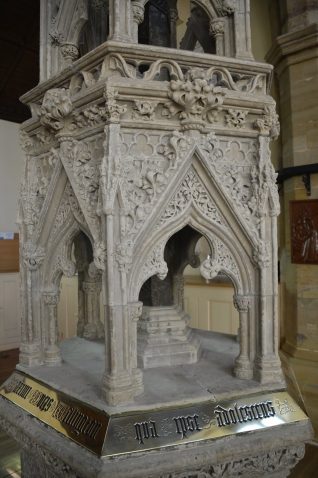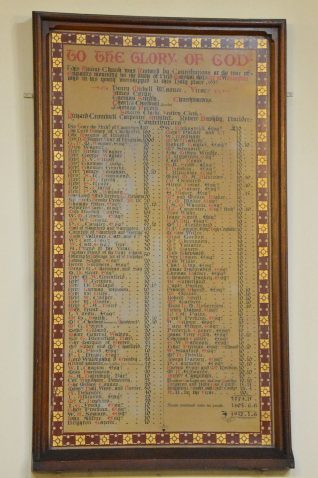The Duke of Wellington memorial was produced by John Birnie Philip (1824-1875) a nineteenth century English sculptor. The 1853 restoration of St Nicholas’ was undertaken in memory of the Duke who had worshipped in the church as a boy. The Latin inscription on the brass plates on the memorial translates as:
In memory of the great Duke of Wellington this sacred building in which, in his youth, he worshipped God, is restored
The following description of the memorial was published in 1854.
‘The memorial is in the style of an Eleanor Cross. The shape is hexagonal. The pedestal commences with a richly moulded base. On the base of the pedestal rests a plinth, covered with diaper work, surmounted by another moulding, on the broad champher of which is an inscription, in old English characters in brass, each line being represented by an angle of the monument. From the pedestal, and above the inscribed moulding, rise two storeys, richly and elaborately decorated with open tracery work and crocketted pinnacles. These are separated by a pierced parapet; a similar one is on the third or upper storey, which is a solid stone drum, each face of which is also ornamented by sunken and carved panels. There follows a canopied niche with a pierced spire surmounted by a finial. In the niche is an alabaster figure of St. George, sheathing his sword over the dragon which lies slain at his feet, symbolic of the career of the Duke. The drum and everything above it rests on a shaft of dark, polished marble which emerges from the pedestal and around which winds a scroll bearing the names of four of the achievements which mark different era’s in Wellington’s military career. Assaye represents the Duke’s Indian Campaign; Torres Vedras, his successful defence of Portugal; Vittoria, the victory which delivered Spain; and Waterloo, the battle which saved Europe.’
Brighton Herald Supplement. 8th April 1854
Click on the images to open a large version in a new window. Click again on image to further enlarge.

Duke of Wellington memorial

Duke of Wellington memorial detail

Duke of Wellington memorial detail

Subscription list for the restoration in memory of the Duke of Wellington




Comments about this page
I have tried to find more information on the Duke of Wellington’s childhood in Brighton, but can find nothing (he worshipped in St Nicholas’ as a boy). Does anyone know anything about this period of his life?
I am a fairly regular visitor to the excellent Wednesday lunchtime recitals but had no idea there was this connection with the Duke. There is a nearby pub named after him too.
Hello Ken, its curious, isn’t it. Yes, there is the Duke of Wellington in Upper Gloucester Rd and the Iron Duke in Waterloo St. However, no B&H bus with his name on it! Hopefully there is a military historian around who can shed some more light on the connection.
Hi Helen. Arthur Wellesley was originally sent to Eton for his education, but much to the concern of his parents, he was not academically doing very well there. After leaving Eton he was sent to Brighton to be tutored by Henry Michell (Vicar of Brighton 1744-89), before going on to a Military College at Angers in France. When the Duke died in 1852, the monument was commissioned by Rev H.M. Wagner, the grandson of Henry Michell. It was at the unveiling that he remarked about Wellesley having a pew at the church whilst he was in Brighton. Some of the Duke of Wellington’s sons were also later tutored by H.M. Wagner, who was a personal friend of the family. Another Brighton connection was that the Duke had travelled in an open Landau with the King to open the new King’s Road on January 29th 1822. Regards, Andy
I had a forbear who was an outrider or postillion to the Duke of Wellington. I think he was from the Wernham family. I also have an ornamental lamp, originally a candle light, now converted to electric, which has as a weight a cannon ball which is reputed to have come from the Battle of Waterloo. The Wernhams were blacksmiths at Egham so it is quite probable that they made this lamp. They were also responsible for repairing the Copper Horse which stands on the Long Walk to Windsor Castle when a wheel broke on the cart that was delivering it and it fell off breaking one of the legs. Wernhams also had the contract for making all the horseshoes for the Castle and for Hampton Court Palace. I also was not aware of the Duke’s Brighton connections until I visited St Nicholas’ a few years ago whilst doing some family research. One of my wife’s family was baptised there around the same time.
Thanks very much Andy and Tim; all really interesting and very helpful information. I have since found that the Duke’s son (Arthur Richard Wellesley, 2nd Duke of Wellington) died at Brighton station! Perhaps a less celebrated Brighton connection.
Add a comment about this page